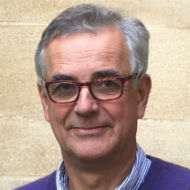Barry Potter
Supernumerary Fellow in Pharmacology; Professor of Medicinal and Biological Chemistry

Contact information
Teaching
I provide mentorship to College graduate students in Chemistry, supervise research students and postdoctoral research associates, give ad hoc lectures and teach and examine in Biomedical Sciences and on the MSc Pharmacology course.
I studied chemistry at Oxford and completed a DPhil on the stereochemistry of enzyme-catalysed phosphoryl transfer. After postdoctoral positions at Oxford and at the Max-Planck-Institute for Experimentelle Medizin in Germany, as Royal Society European Exchange Fellow, I was Lecturer in Biological Chemistry at Leicester University, winning a Lister Institute Fellowship, and later moving to the Established Chair of Medicinal Chemistry at the University of Bath as Head of Section. I have been a Visiting Professor at Oxford since 2006, a Wellcome Trust Senior Investigator since 2013 and in 2015 was appointed Professor of Medicinal and Biological Chemistry in the Department of Pharmacology. Our work in the two main research areas below has been recognized by both academic awards – several Royal Society of Chemistry medals and lectureships – and industrial prizes – the Glaxo Smith Kline International Achievement Award and a European Life Science Award.
Research
My work is highly collaborative and international and concerns the interaction of Chemistry with Biomedical Science: the design, synthesis and biological evaluation of active organic molecules at the Chemistry & Biology interface aimed at dissection of fundamental mechanisms; and drug design at the Chemistry & Medicine interface to move translationally from ‘concept to clinic’. The two main research themes are:
The Chemistry of Cell Signalling: In this Chemical Biology area a unifying theme concerns cellular signalling – the chemistry of signal transduction, particularly involving “second messengers” signalling through intracellular calcium, as well as molecules involved in endocrine signalling and its modulation in oncology and endocrinology. My group is a leader internationally in exploring signalling pathways involving inositol polyphosphates and adenine nucleotides using synthetic tools. Synthetic chemistry for structure-based design is underpinned by biochemical assays, protein crystallography and in silico computational modelling.
Anticancer Drug Design & Discovery: In this Medicinal Chemistry area we have achieved the rare goal of Academic Drug Discovery to the benefit of cancer patients and in women’s health. We have defined novel therapeutic concepts and drug targets, pioneered a new structural motif and brought “first-in class” compounds from the academic laboratory to many international Phase I and II human clinical trials. Our drugs have been clinically administered to patients with advanced metastatic breast cancer, endometrial cancer, prostate cancer and endometriosis. Positive indications of efficacy include responses, disease stabilisation and increased progression-free survival. Excitingly, a recent UK trial has shown the first evidence of clinical activity in early breast cancer.
Selected Publications
2ʹ-Deoxyadenosine 5ʹ-diphosphoribose is an endogenous TRPM2 superagonist. R Fliegert, A Bauche, A-M Wolf Pérez, J M Watt, M D Rozewitz, R Winzer, M Janus, F Gu, A Rosche, A Harneit, M Flato, C Moreau, T Kirchberger, V Wolters, B V L Potter and A H Guse, Nature Chemical Biology (2017) 13, 1036-1044. See: dx.doi.org
The mechanism of activation of class I HDAC complexes by inositol phosphates. P J Watson, C J Millard, A M Riley, N S Robertson, L C Wright, H Y Godage, S M Cowley, A G Jamieson, B V L Potter and J W R Schwabe, Nature Communications (2016) 7, 11262. See: nature.com
Crystal Structures of Type-II Inositol Polyphosphate 5-Phosphatase INPP5B with synthetic inositol polyphosphate surrogates reveal new mechanistic insights for the inositol 5-phosphatase family. S J Mills, C Silvander, G Cozier, L Trésaugues, P Nordlund, and B V L Potter, Biochemistry (2016) 55, 1384-1397. See: pubs.acs.org
The “Other” Inositols and Their Phosphates: Synthesis, Biology & Medicine (with Recent Advances in myo-Inositol Chemistry). M P Thomas, S J Mills & B V L Potter, Angewandte Chemie Int Edn Eng (2016) 55, 1614-1650. See: dx.doi.org
Discovery and Development of the Aryl O-Sulfamate Moiety for Oncology and Women’s Health. M P Thomas & B V L Potter, J Med Chem (2015) 58, 7634-7658. See: doi.org
Structure-activity relationship of adenosine diphosphoribose at the TRPM2 channel: Rational design of ADPR antagonists.C Moreau, T Kirchberger, J M Swarbrick, S J Bartlett, Y Timur, R Fliegert, T Yorgan A Bauche, A Harneit, A H Guse and B V L Potter, J Med Chem (2014) 56, 10079-10102. See: pubs.acs.org
Synthesis, antitubulin and anti-proliferative SAR of C3/C1 substituted N-benzyl-7-methoxy 6-O-sulfamoyl-1, 2, 3, 4-tetrahydroisoquinolines. W Dohle, M P Leese, F Jourdan, M R Major, R Bai, E Hamel, Eric Ferrandis, A Fiore, S P Newman, A Purohit and B V L Potter, ChemMedChem (2014) 9, 350-370. See: dx.doi.org
Synthetic inositol phosphate analogues reveal that PPIP5K2 has a surface-mounted substrate capture site that is a target for drug discovery. H Wang, H Y Godage, A M Riley, J D Weaver S B Shears and B V L Potter, Chemistry & Biology (2014) 21, 689-699. See: dx.doi.org
X-Ray crystal structure of a synthetic polyphosphoinositide headgroup surrogate in complex with SHIP2 reveals options for drug discovery. S J Mills, C Persson, G Cozier, M P Thomas, L Trésaugues, C Erneux, A M Riley, P Nordlund and B V L Potter, ACS Chemical Biology (2012) 7, 822−828. See: dx.doi.org
NAADP mediated Ca2+ signaling via type 1 ryanodine receptor in T cells revealed by a novel NAADP antagonist.W Dammermann, B Zhang, M Nebel, C Cordiglieri, F Odoardi, T Kirchberger, N Kawakami, J Dowden, F Schmid, M Hohenegger, A Flügel, A H Guse and B V L Potter, Proc Natl Acad Sci USA (2009) 106, 10678-10683. See: dx.doi.org